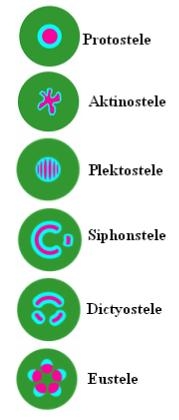Stele (botany)
As a stele ( Greek στήλη "column") is called the totality of the primary conductive tissue in botany . Eight types of steles can be distinguished (according to Strasburger , 35th edition).
Stel types
- Protostele: The entirety of the conduction pathways is limited to a single (central) concentric vascular bundle . There are forms in which the xylem is on the outside and the phloem is on the inside (perixylematic), and vice versa (periphloematic). This is probably the most original form, it was typical of the first land plants (e.g. primeval ferns ), but is still found in some young forms of ferns today .
- Actinostele: Single central vascular bundle with the xylem on the inside and star-shaped in cross-section (Greek ακτινοτός "surrounded by rays"). The phloem fills the 'ray spaces' of the 'xylem star'. It also occurred in primeval ferns. Today it is particularly widespread among the fork-leaf plants and the bear moss plants . This type is also found in roots in the form of central cylinders.
- Plectostele: (Greek πλεκτός "braided") Is understood as a transition form to the next types. It (still) consists of a central undivided strand of conductive tissue, which (already) has several separate xylem and phloem areas. This is the most common type of bear moss .
- Polystele: Several concentric axially parallel vascular bundles that are distributed over the entire stem cross-section. One assumes a phylogenetic development from the actinostele through fissures.
- Siphonostele: tubular vascular bundle cord (Greek σίφον "tube") that surrounds the medulla . There are limited gaps in the tube at the attachment points for leaves . This is the stele type of some fern families.
- Dictyostele: very similar to the siphonostele. In contrast to this, there is no closed tube here, but a tubular network. (Greek δίκτυον "network"). The term bundle tube is sometimes used for this type of stele, which is typical for most ferns. Each individual vascular bundle is concentric and surrounded by a pericycle and an endodermis .
- Eustele: stele type of the dicotyledonous . The collateral vascular bundles are usually fused into a cylinder (especially in trees ) and (only) separated from each other by wood rays . So this type of stele actually corresponds to a single concentric vascular bundle (cf. protostele) with enclosed pith.
- Ataktostele: (Greek άτακτος "disordered") type of stele in monocotyledons . The closed collateral vascular bundles are irregularly distributed over the cross-section of the stem axis (cf. Polystele), but the xylempoles of the vascular bundles are always directed towards the center of the stem axis cross-section. For this reason, one assumes a single concentric vascular bundle as the initial shape. The fact that a tissue sheath encompassing stelae is indicated in part supports this assumption.
See also
literature
- Peter Sitte , Elmar Weiler , Joachim W. Kadereit , Andreas Bresinsky , Christian Körner : Textbook of botany for universities . Founded by Eduard Strasburger . 35th edition. Spektrum Akademischer Verlag, Heidelberg 2002, ISBN 3-8274-1010-X .
Web links
Wiktionary: Stele - explanations of meanings, word origins, synonyms, translations
